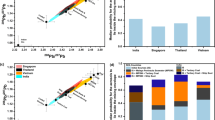Abstract
Background
Standard approaches for the assessment of Man via the Environment exposure are designed to be conservative. However, propagating these exposures into health impact assessment might lead to questionable socio-economic costs.
Objective
The objective of this study was to develop a novel tiered modelling approach to assess human exposure to lead (Pb) via the environment.
Method
The approach starts in Tier 1 from EUSES modelling approach, modified with metal specific transfer factors. The generic Tier 2 approach uses the higher tier model GPM for air quality, and dietary exposure modelling based on EFSA’s Comprehensive Food Database, in combination with crop specific transfer factors. Tier 3 considers additional site-specific information such as proximity of inhabitants and agricultural activities in relation to industrial sites.
Results
This tiered modelling approach was applied to a case study of 50 lead battery manufacturing and recycling sites across Europe. Data sets from general population human biomonitoring studies were used to compare the predicted additional bioburden of Pb resulting from lead battery manufacturing and recycling. The higher tier assessments were able to demonstrate a >20-fold reduction in modelled Pb exposure compared to default assumptions made in Tier 1.
Significance
Leading to better estimates for socio-economic costs in health impact assessment.
This is a preview of subscription content, access via your institution
Access options
Subscribe to this journal
Receive 6 print issues and online access
$259.00 per year
only $43.17 per issue
Buy this article
- Purchase on Springer Link
- Instant access to full article PDF
Prices may be subject to local taxes which are calculated during checkout



Similar content being viewed by others
References
Vermeire TG, Jager DT, Bussian B, Devillers J, Den Haan K, Hansen B, et al. European Union System for the Evaluation of Substances (EUSES). Principles and structure. Chemosphere. 1997;34:1823–36.
ECHA. Guidance on information requirements and Chemical Safety Assessment Chapter R.16: Environmental exposure assessment. Version 3.0 February 2016. https://www.echa.europa.eu/documents/10162/13632/information_requirements_r16_en.pdf/b9f0f406-ff5f-4315-908e-e5f83115d6af
Fierens T, Van Holderbeke M, Standaert A, Cornelis C, Brochot C, Ciffroy P, et al. Multimedia & PBPK modelling with MERLIN-Expo versus biomonitoring for assessing Pb exposure of pre-school children in a residential setting. Sci Total Environ. 2016;568:785–93.
Buekers J, De Brouwere K, Lefebvre W, Willems H, Vandenbroele M, Van Sprang P, et al. Assessment of human exposure to environmental sources of nickel in Europe: Inhalation exposure. Sci Total Environ. 2015;521-2:359–71.
MacLachlan DJ. Estimating the transfer of contaminants in animal feedstuffs to livestock tissues, milk and eggs: a review. Anim Prod Sci. 2011;51:1067.
Schreck E, Foucault Y, Sarret G, Sobanska S, Cécillon L, Castrec-Rouelle M, et al. Metal and metalloid foliar uptake by various plant species exposed to atmospheric industrial fallout: Mechanisms involved for lead. Sci Total Environ. 2012;427-8:253–62.
Shahid M, Dumat C, Khalid S, Schreck E, Xiong T, Niazi NK. Foliar heavy metal uptake, toxicity and detoxification in plants: A comparison of foliar and root metal uptake. J Hazard Mater 2017;325:36–58.
US EPA. United States Environmental Protection Agency. Office of Solid Waste and Emergency Response (5305W). Human health risk assessment protocol for hazardous waste combustion facilities; 2005. EPA 530/R/05/006. Final Report. 2005. www.epa.gov/osw
De Brouwere K, Buekers J, Cornelis C, Schlekat CE, Oller AR. Assessment of indirect human exposure to environmental sources of nickel: Oral exposure and risk characterization for systemic effects. Sci Total Environ. 2012;419:25–36.
Oliva SR, Raitio H. Review of cleaning techniques and their effects on the chemical composition of foliar samples. Boreal Environ Res. 2003;8:263–72.
Talard R, Piasecka A, Navis S, Geerts, L De Brouwere K, Verdonck F. Derivation of lead transfer factors and bioaccumulation factors for Man Via environment exposure assessment. Technical report. Arche Consulting, Gent, Belgium. 2019.
ILA. International Lead Association. Lead Metal. EU Reach Registration Chemical Safety Report. 2020.
ECETOC. Technical Report No 58. Assessment of Non-occupational Exposure to Chemicals. European Centre for Ecotoxicology and Toxicology of Chemicals ISSN-0773-8072-58. 1994.
ECHA. European Chemicals Agency. Annex xv restriction report proposal for a restriction substance name: lead iupac name: Not applicable CAS NUMBER: 7439-92-1. 2017; 0–84.
Carlisle JC, Wade MJ. Predicting blood lead concentrations from environmental concentrations. Regul Toxicol Pharm. 1992;16:280–9.
WHO. World Health Organization. Air Quality Guidelines for Europe—second Edition World Health Organization. Regional Office for Europe. 2000.
Beaugelin-Seiller K, Cessac B, Marot F, Chartier C, Deportes I, Metivier J-M et al. La banque de données CIBLEX, une compilation de paramètres d’exposition de la population française au voisinage d’un site pollué. Déchets, Rev Francoph D’ÉCOLOGIE Ind 2004. https://doi.org/10.4267/dechets-sciences-techniques.2125.
DEFRA. Department for the Environment, Food and Rural Affairs. The contaminated land exposure assessment (CLEA) model. Technical basis and algorithms (report)
EFSA. Scientific Opinion on Lead in Food. EFSA J. 2010;8:1–151.
Rudnai P. Human biomonitoring for Europe. HBM4EU Science and policy for a healthy future. SCOPING DOCUMENT (2 nd round of prioritization) prioritized substance group: Lead. Horizon 2020 programme Contract No 733032. 2019. Available on https://www.hbm4eu.eu
Clune A, Falk H, Riederer A. Mapping Global Environmental Lead Poisoning in Children. Blacksm Inst J Heal Pollut. 2011;1. https://doi.org/10.5696/jhp.v2i2.26.
Fryer M, Collins CD, Ferrier H, Colvile RN, Nieuwenhuijsen MJ. Human exposure modelling for chemical risk assessment: a review of current approaches and research and policy implications. Environ Sci Policy. 2006;9:261–74.
Acknowledgements
This work was funded by the Lead REACH Consortium.
Author information
Authors and Affiliations
Contributions
KDB and FV developed together the tiered approach framework. KDB performed tier 2 and 3 calculations for the local scale regarding dietary exposure and integrated exposure, and verified the predictions using human biomonitoring data. FV developed the Tier 1 concept, and performed tier 1 calculations for the local scale. LG calculated conversion factors from external to internal exposure. SN derived transfer factors for Tier 1 and Tier 2 dietary exposure calculations. MV performed Tier 2 calculations (GPM modelling) for the inhalation pathway.
Corresponding author
Ethics declarations
Competing interests
Besides the financing of the work by the Lead REACH Consortium, we have no competing financial interests or personal relationships that could have appeared to influence the work reported in this paper.
Additional information
Publisher’s note Springer Nature remains neutral with regard to jurisdictional claims in published maps and institutional affiliations.
Supplementary information
Rights and permissions
About this article
Cite this article
De Brouwere, K., Verdonck, F., Geerts, L. et al. Assessment of human exposure to environmental sources of lead arising from the lead battery manufacturing and recycling sector in Europe: demonstration of a tiered approach in a case study. J Expo Sci Environ Epidemiol 32, 418–426 (2022). https://doi.org/10.1038/s41370-021-00395-5
Received:
Revised:
Accepted:
Published:
Issue Date:
DOI: https://doi.org/10.1038/s41370-021-00395-5



